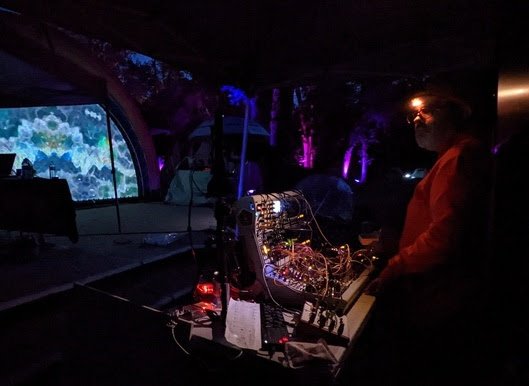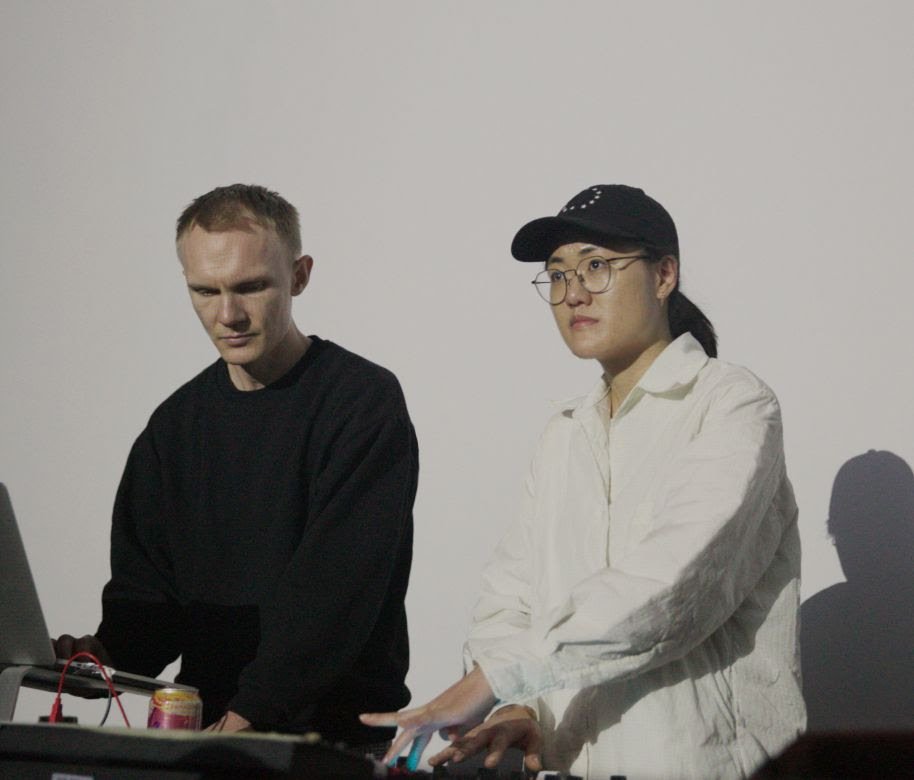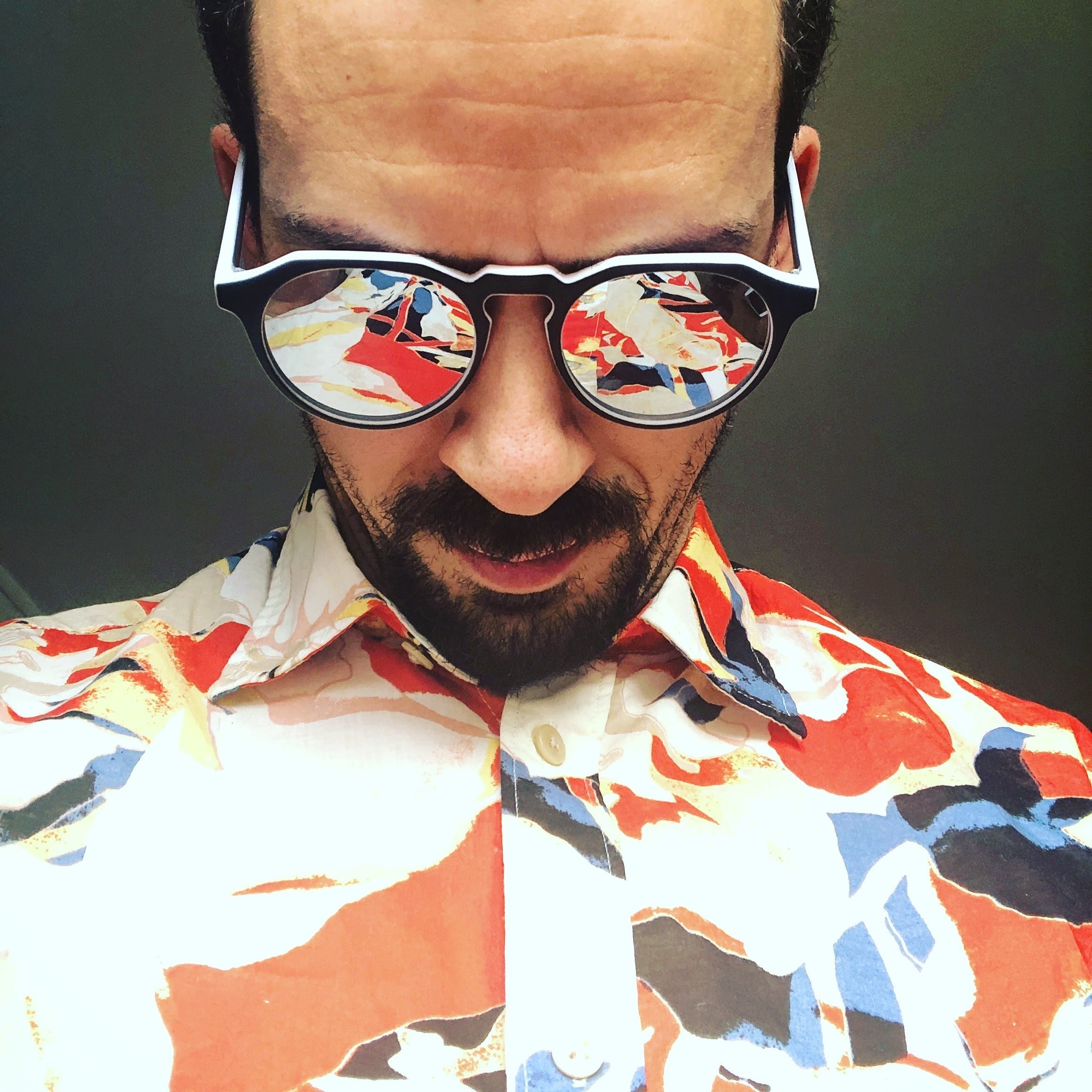welcome to
Saturday, November 12, 2022
8:00 pm at Heron Arts
Thank you for being a part of One Found Sound’s tenth season!
You make each performance so incredible and unique, and we are thrilled to share this amazing music with you tonight.
• • •
Formation features immersive lighting and visuals by Max Savage, Dr. Rek, and Subset.
Photosensitivity warning: this show might not be safe for some people with epilepsy. Some lighting used at this show may be disruptive to people who are sensitive to light. For more information about photosensitivity please visit leaddiy.org
program
Estevan Olmos - Mi Cultura Lejana* [world premiere]
*Winner, One Found Sound's 2022 Emerging Composer Award
Featuring audio-reactive visuals by Max Savage
One Found Sound’s 2022 Emerging Composer Award was made possible by a generous gift from the Richards Family. Read more about this award here.
• • •
Dmitri Shostakovich - Chamber Symphony in C minor, Op. 110a (arr. Rudolf Barshai)
Featuring audio-reactive visuals by Dr. Rek
I. Largo
II. Allegro molto
III. Allegretto
IV. Largo
V. Largo
These movements are performed without pause.
• • •
Gabriela Lena Frank - Elegía Andina
• • •
Michael Gilbertson - Graffiti: Concerto for Chamber Orchestra
Featuring audio-reactive visuals by Subset
I. eye-opener
II. spray
III. slow jam
IV. bubble letters
V. shake
VI. again and again
land acknowledgement
One Found Sound respectfully acknowledges that the land on which we are gathered for this performance, and on which we have gathered for our rehearsals, is located on the unceded ancestral homeland of the Ramaytush Ohlone peoples—specifically the Yelamu—an independent tribe of the Ramaytush Ohlone that once inhabited what is now known as San Francisco County.
We share our acknowledgement with you to pay our respects to the ancestors, elders, descendants, and relatives of the Ramaytush Ohlone peoples; to affirm and promote consciousness of the cultural and sovereign rights of First Peoples; as a step in our continuing efforts to recognize the ongoing atrocities and brutalities of colonialism; and as a step in understanding our place in the process of decolonization and reconciliation as individuals, as artists, as an orchestra, and as a community.
We recognize that the Ramaytush Ohlone Peoples, as the original stewards of this land, understood the interconnectedness of all things and maintained harmony with nature for millennia, and we honor them for their enduring commitment to Mother Earth.
———
Visit the Association of Ramaytush Ohlone online at ramaytush.org
one found sound
violin
Katie Allen
Stephanie Bibbo
Kashi Elliott
Miles Huang
Michell Maruyama
Michael Nicholson
Darren Sagawa
Charmian Stewart
Anna Washburn
Sam Weiser
viola
Rachel Haber
Nao Kubota
Samuel Nelson
Alexandra Simpson
cello
Megan Chartier
Byron Hogan
James Jaffe
Helen Newby
bass
Scott Padden
Lalita Perez Acosta
flute
Izzy Gleicher
Drew Powell
oboe
Jesse Barrett
Colton Potter
clarinet
Sarah Bonomo
Cory Tiffin
bassoon
Georgeanne Banker
Jamael Smith
horn
Patrick Jankowski
Caitlin Smith Franklin
trumpet
Robert Giambruno
Ari Micich
percussion
Sohrab Bazargannia
Divesh Karamchandani
harp
Jennifer Ellis
Estevan Olmos
Mi Cultura Lejana
Estevan Olmos
"This piece is meant to evoke a sense of nostalgia and yearning for one's own 'distant culture.' Hence the name, Mi Cultura Lejana, which translates to 'my distant culture.' As a U.S. born Mexican-American, I have witnessed firsthand how in the United States, Mexican culture slowly fades from generation to generation. My parents' grasp on Mexican culture is slightly different than my grandparents' which begs the question, at what point are we still Mexican? If my family traditions are lost, are we still Mexican?
“I do not claim to have answers to these questions, but what I do know is that many other people in the United States can relate to this. As a country of immigrants and natives, we all have a distant culture that we come from. Some are more connected to it than others but it is still there. Although this piece is specifically about my distant culture, I hope many others can relate to it as well (not just Mexican-Americans)." - Estevan Olmos
Estevan Olmos is an undergraduate music composition major at California State University, Fresno. His experience as a percussionist results in music that explores how rhythm can be used to subvert the listener’s expectations. Estevan was a finalist in the Second Annual Fresno State Art Song Competition in 2019 and won the NAFME national electronic composition competition in 2020. As a Mexican-American musician, Estevan Olmos aims to create a fusion between the traditional Mexican music he grew up with and classical music.
———
Estevan Olmos is the winner of One Found Sound's 2022 Emerging Composer Award, an annual award that supports the performance of new music by aspiring young composers under the age of 25 who identify as Black, Indigenous, Latina or Latino, Asian, Pacific Islander, or as a person of color. Selected from an annual call for scores, the winning composition is performed and recorded live by One Found Sound. Read more about this award here.
Our 2022 Emerging Composer Award is made possible by a generous gift from The Richards Family.
Dmitri Shostakovich (1906 - 1975)
Chamber Symphony in C minor, Op. 110a
(arr. Rudolf Barshai)
I. Largo
II. Allegro molto
III. Allegretto
IV. Largo
V. Largo
Dmitri Shostakovich
“As hard as I tried to rough out film scores which I am supposed to be doing, I still haven’t managed to get anywhere; instead I wrote this ideologically flawed quartet which is of no use to anybody,” Dmitri Shotakovich wrote to his friend and secretary, the critic and pedagogue Isaac Glikman in July of 1960. “I started thinking that if some day I die, nobody is likely to write a work in memory of me, so I had better write one myself. The title page could carry the dedication: ‘To the memory of the composer of this quartet.’”
That year, Shostakovich was invited to Dresden to compose the score for Five Days, Five Nights, a Soviet-East German drama depicting the Russian search for artwork in the immediate aftermath of the Dresden firebombing of February 1945.
Dresden’s utter devastation “made a terrific impact on me," Shostakovich wrote, so much so that when he retreated to the bucolic town of Königstein to compose the film score, he instead ended up with a work so deeply personal, profound, and intimately introspective: his eighth string quartet. Seven years later, with Shostakovich’s blessing, the quartet was arranged by his colleague, the violist and conductor Rudolf Barshai, as the Chamber Symphony in C minor, Op. 110a.
“The basic theme of the quartet is the four noted D natural, E flat, C natural, B natural—that is, my initials, D. SCH,” Shostakovich wrote to Glikman. “The quartet also uses themes from some of my own compositions and the Revolutionary song ‘Zamuchen tyazholoy nevolyey’ [‘tormented by grievous bondage’].” This work includes cameos from Shostakovich’s Symphony No. 1—written when he was just 19—his first cello concerto; Lady Macbeth of Mtsensk; as well as borrowings Pyotr Iliyich Tchaikovsky’s Symphony No. 6, “Pathétique,” and the funeral march from Richard Wagner’s Götterdämmerung. “Quite a nice little hodge-podge, really,” Shostakovich continued.
While describing the work as self-referential, Shostakovich enigmatically remarked: “It is a pseudo-tragic quartet, so much that while I was composing it I shed the same amount of tears as I would have to pee after half-a-dozen beers. When I got home, I tried a couple of times to play it through, but always ended up in tears. This was of course a response not so much to the pseudo-tragedy as to my own wonder at its superlative unity of form. But here you may detect a touch of self-glorification, which no doubt will soon pass and leave in its place the usual self-critical hangover.”
“So that’s my news,” Shostakovich concluded his correspondence to Glikman. This news spread quickly, and the quartet soon became one of the composer’s most legendary works.
Though sparked by the harrowing impressions Dresden left on him, it is not difficult to hear this music as a sort of personal eulogy as well. That same year, Shostakovich had been coerced into joining the Communist Party. “They’ve been pursuing me for years, hunting me down,” he reportedely said to a friend. This move was as much a necessary step to secure his position as First Secretary of the Russian Soviet Federated Socialist Republic Composers Union as it was a means of having his music previously banned by the party heard in Russian concert halls once again. The decision to join tormented the composer: “Never before had I seen Shostakovich in a such a state of hysterical collapse,” a friend remarked that year.
Just like the source quartet, the Chamber Symphony in C minor is composed in five movements that are performed continuously. One dramatic focal point occurs in the fourth movement, which begins with three striking, repeated eighth notes that shatter the stillness of a long, quiet A-sharp played by a lone violin. The composer’s son Maxim described this as “knocks on the door by the KGB;” others have suggested that the motif represents harsh gunfire, sounding against the drone of an airplane. As the interruptions cease, the held note quietly morphs into the first four notes of the Latin “Dies Irae” chant—a permutation of the DSCH motif—whose text describes the Day of Judgment.
At the top of the score, Shostakovich dedicated this work “In memory of victims of fascism and war.”
— Note by Georgeanne Banker
Gabriela Lena Frank (b. 1972)
Elegía Andina
Gabriela Lena Frank
"Elegía Andina for Orchestra (2000) is dedicated to my older brother, Marcos Gabriel Frank. As children of a multicultural marriage (our father being Lithuanian-Jewish and our mother being Chinese-Peruvian-Spanish), our early days were filled with Oriental stir-fry cuisine, Andean nursery songs, and frequent visits from our New York-bred Jewish cousins. As a young piano student, my repertoire included not only my own compositions that carried overtones from Peruvian folk music but also rags of Scott Joplin and minuets by the sons of Bach. It is probably inevitable then that as a composer and pianist today, I continue to thrive on multiculturalism.
”Elegía Andina (Andean Elegy) is one of my first written-down compositions to explore what it means to be of several ethnic persuasions, of several minds. It uses stylistic elements of Peruvian arca/ira zampoña panpipes (double-row panpipes, each row with its own tuning) to paint an elegiac picture of my questions. The flute part was particularly conceived with this in mind but was also inspired by the technical and musical mastery of Floyd Hebert, principal flutist of the Albany Symphony Orchestra. In addition, as already mentioned, I can think of none better to dedicate this work to than to 'Babo,' my big brother — for whom Perú still waits." - Gabriela Lena Frank
"Currently serving as Composer-in-Residence with the storied Philadelphia Orchestra and included in the Washington Post's list of the most significant women composers in history (August, 2017), identity has always been at the center of composer/pianist Gabriela Lena Frank's music. Born in Berkeley, California (September, 1972), to a mother of mixed Peruvian/Chinese ancestry and a father of Lithuanian/Jewish descent, Gabriela explores her multicultural heritage through her compositions. Inspired by the works of Bela Bartók and Alberto Ginastera, Gabriela has traveled extensively throughout South America in creative exploration. Her music often reflects not only her own personal experience as a multi-racial Latina, but also refract her studies of Latin American cultures, incorporating poetry, mythology, and native musical styles into a western classical framework that is uniquely her own."
- Gabriela Lena Frank Creative Academy of Music. Read more about Gabriela Lena Frank online here.
Michael Gilbertson (b. 1987)
Graffiti: Concerto for Chamber Orchestra
I. eye-opener
II. spray
III. slow jam
IV. bubble letters
V. shake
VI. again and again
Michael Gilbertson
Photo by Christina Simpson
"Living in the Bay Area…I’ve been struck by the vibrancy of the city’s streets and, in particular, the graffiti and street art scene. As I approached composing a concerto for chamber orchestra, I purchased a book of photographed graffiti from around the Bay Area, and decided to its images and ideas as a basis for movements of the concerto. In reading statements from graffiti artists, I was struck by the creative drive behind their works—a deep desire for their voices to be seen and known, and an embrace of the transgressive nature of their art. These artists’ drive, and thier varied, visually dynamic works, inspired this concerto." - Michael Gilbertson
The works of Michael Gilbertson have been described as “elegant” and “particularly beautiful” by The New York Times, “vivid, tightly woven” and “delectably subtle” by the Baltimore Sun, “genuinely moving” by the Washington Post, and “a compelling fusion of new and ancient” by the Philadelphia Inquirer. In 2017 Gilbertson joined the faculty of the San Francisco Conservatory of Music and began a tenure as BMI Composer in Residence with the San Francisco Chamber Orchestra. He was one of three finalists for the 2018 Pulitzer Prize in Music for his Quartet.
- From MichaelGilbertson.net. Read more about Michael Gilbertson online here.
Meet the Visual Artists
Dr. Rek
Dr. Rek aka Derek Sajbel has been producing music, performing live, DJing, and VJing around the world since the late 90s. Dr. Rek dived into modular video synthesis in 2018, using hardware to generate and composite unique visuals for each performance and livestream he’s been lucky to be a part of. https://linktr.ee/Dr_Rek
Video Synthesis was pioneered by artists like Nam Jun Paik, Shuya Abe, Dan Sandin and other academics, engineers and artists in the 1960s and 1970s, commercialized with the Scanimate from Computer Image Corporation, carried into digital by Fairlight’s Computer Video Instrument in the 1980s, and revived into an eurorack modular standard by LZX industries in the late 2000s. The compact eurorack modular format developed by Doeper Musikelektronik in the mid 1990s created an analog renaissance explosion of small boutique vendors of audio and video synthesis modules. For this performance Dr. Rek generates live audio-reactive waveforms and shapes, mixed and colorized with a new analog high-definition modular video synthesis workflow from LZX industries.
Subset
Subset (Andreas Brændhaugen and Sarah Nahm) have been creating visuals to live music since the late 2000s. A staple of San Francisco’s underground party circuit, Subset has become the local go-to visuals provider for the techno vanguard – artists like Luke Slater, Drew McDowall, Orphx, Kyoka, Silent Servant, Rrose, Marcel Dettmann, Perc, Hiro Kone, and many more.
Subset’s visuals leap from constrained to anarchic, with brooding compositions made from primitive geometric forms, digital detritus, weird science videos, and sound reactive structures.
www.bysubset.com / IG: @wearesubset
Max Savage
Max Savage (@noisysavage) is an audiovisual artist, producer and filmmaker based in San Francisco. He has a kinetic, emotional and cinematic style that inspires both his music production and video work. Working with artists such as New Spell, Cathedrals and Myyth as well as winning the 2021 AI Music Contest as a part of M.O.G.I.I.7.E.D.
Savage is also exploring the intersection of A.I. and immersive visuals as resident filmmaker for the conductorless SF- based orchestra, One Found Sound.
Thank you for being a part of One Found Sound!
From artist compensation to concert production costs, your support helps our orchestra thrive. All proceeds from tonight’s event will support our 2022-2023 season, helping us bring classical music to wider audiences in our community through unique concert experiences.
Thank you for making your tax-deductible contribution at our performance tonight, or by clicking the link below.
Become a Onesie! Chat with us at the Onesie table near the patio door tonight, or visit us online to learn more about the perks of joining our exciting Onesie patron program.
See you at our next show, Holiday Pop Rox!, coming up on Saturday, December 10! Click below to get your tickets and for season details 🎟
Thank you to our Onesies!
Crystal
$10,000 annually or $2,500 quarterly
Anonymous
James F. Bonomo, Gabriella Bonomo, Adam Bonomo, Kitty
Ruby
$5,000 annually or $1,250 quarterly
Rick Launer and Amy Sadoff
Connie Zweigle
Emerald
$2,500 annually or $625 quarterly
Anonymous (3)
Jeff Padden
Mark Slee & Chloé Blain
Brad Taylor
Diamond
$1,000 annually or $250 quarterly
Anonymous
Gerard Buulong & Fred Silverman
Crane Data Centers
Beau Davenport
Linda Dembo and Stephen Smoliar
Erik Goldman
Dean Gooch
Brien Henderson
Zack Launer
Peter Nelson
Kiran & Leela Richards
Marco Rozzano
Andrew Watterson and Keith Kurson
Velvet
$500 annually or $125 quarterly
Anonymous (4)
Alessandra Aquilanti & Josh Walden
Elizabeth Arai
Bill & Shirley Banker
Ann & Scott Botel-Barnard
Frank Daffin & Amy Barrett-Daffin
Samantha Goldstein
Riccardo Guidi
Melissa G. Hernandez
Nicola Shangrow Reilly
Christopher Slee
Tom and Karen Tsueipauer
Chris Zweigle
Sparkle
$200 annually or $50 quarterly
Antoinette Barrett
Hilary Beech
Martin & Kathleen Cohn
Lisa Eltinge and Jonathan Burton
Sherri Cornett & Steve Kriner
E and J
Jon Gooblar
Phil & Valerie Heller
J.D. Hogan
Curt Holzinger
Steven Horwitz
Donna & Mike Kaplan
Cynthia Launer & Will Thomas
Carol Lewis
Helise Mack
Ken Marson
Sejal Patel
Kala Perkins
Utthara R.
Dr. Susan Raeburn
Lou Scott
Michel Taddei
Paul Van Cleave
One Found Sound thanks our sponsors!
Heron Arts
Hogan Lovells
Lagunitas Brewing Company
Google for Nonprofits
AmazonSmile
Clarence E. Heller Charitable Foundation
State of California











